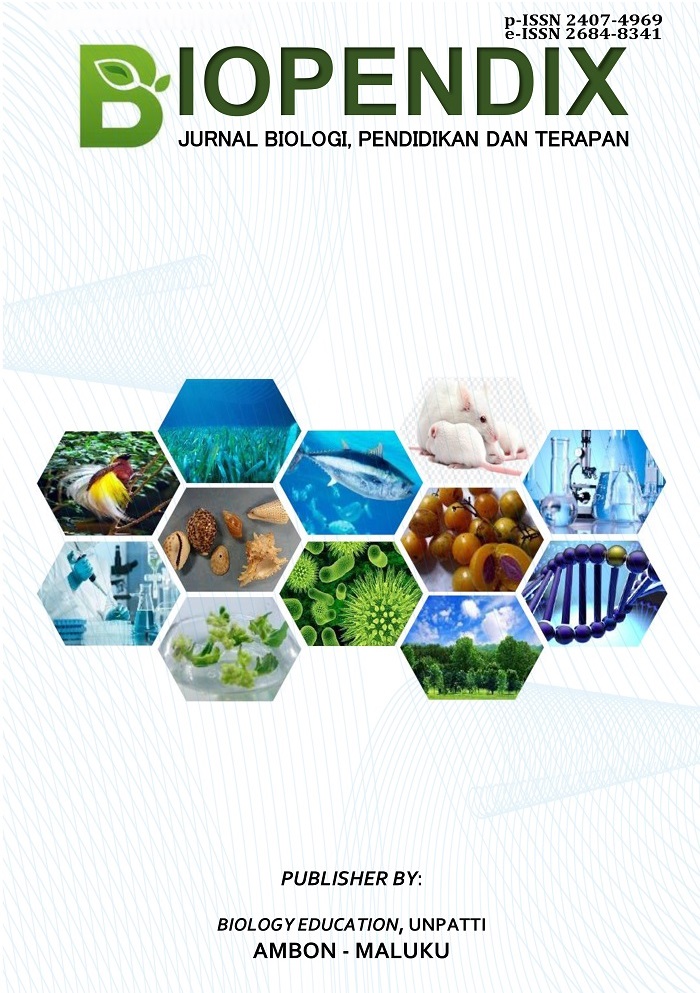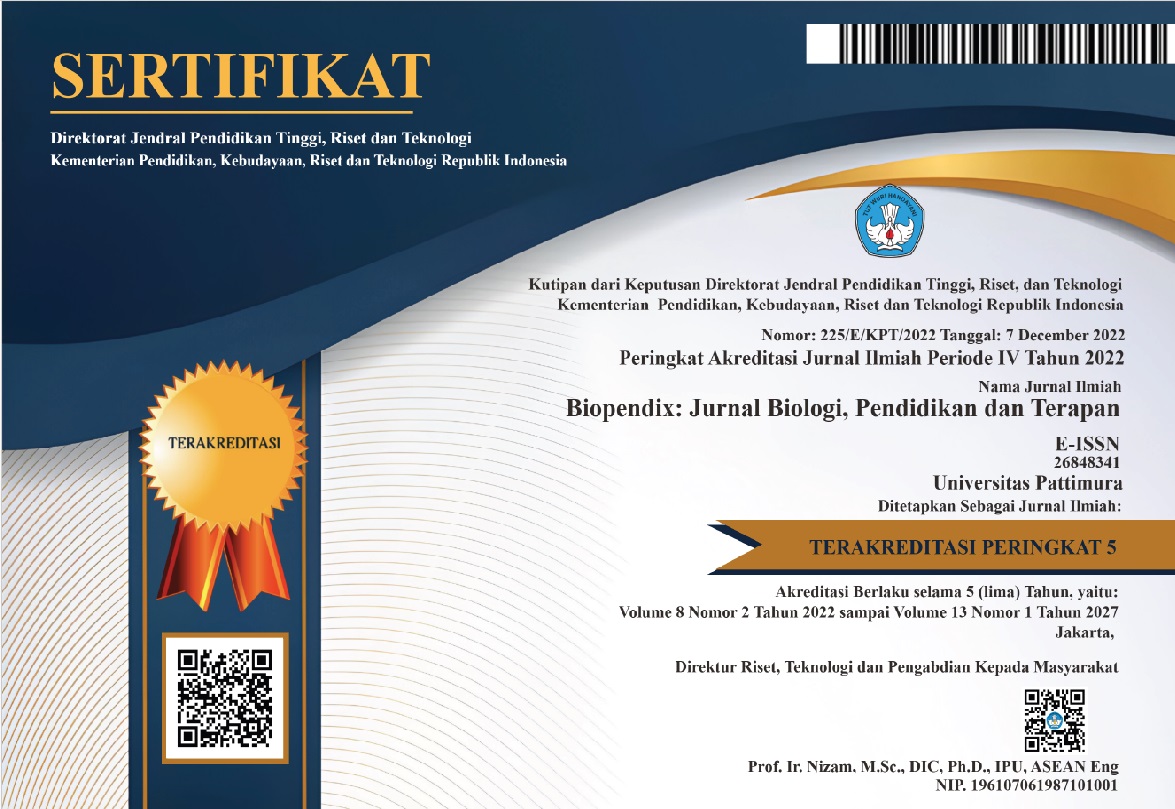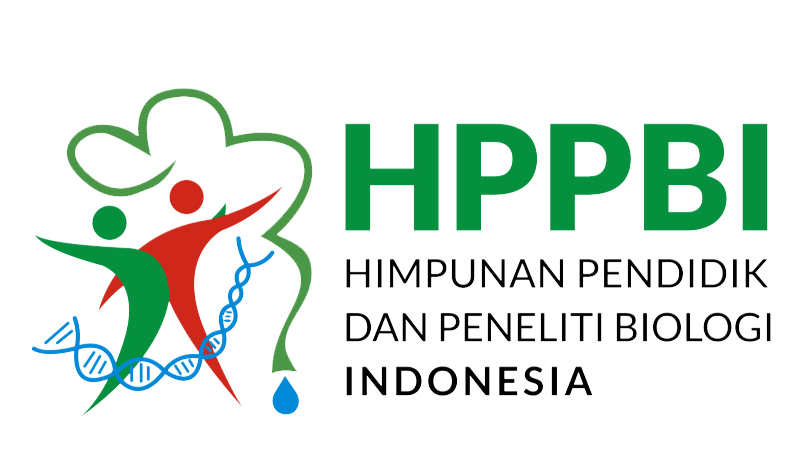Spatial Analysis of the Relationship between Vegetation Index and Land Surface Temperature in Ternate Island, Indonesia
Abstract
This research focuses on the spatial analysis of the relationship between vegetation index and land surface temperature in Ternate Island, Indonesia, which is becoming increasingly relevant amidst the phenomenon of rapid urbanization. The background of the research shows that land use change has the potential to reduce green open space, contributing to an increase in surface temperature that can trigger the Urban Heat Island (UHI) phenomenon. The methods used include utilizing Landsat 8 OLI/TRIS satellite image data to calculate NDVI and LST values and statistical analysis using Pearson's correlation test and Spearman's rho to identify the relationship between the two. The results showed a significant negative relationship between NDVI and LST, with a Pearson correlation coefficient of -0.613, indicating that areas with better vegetation cover tend to have lower surface temperatures, and non-vegetated areas influence the increase of land surface temperature. The discussion highlights the importance of vegetation in regulating surface temperature through evapotranspiration and shading processes and suggests the need for afforestation strategies to mitigate climate change on Ternate Island
Downloads
References
Ahmad, B., Najar, M. B., & Ahmad, S. (2024). Analysis of LST, NDVI, and UHI patterns for urban climate using Landsat-9 satellite data in Delhi. Journal of Atmospheric and Solar-Terrestrial Physics, 265, 106359. https://doi.org/10.1016/j.jastp.2024.106359
Anand, S., Kumar, H., Kumar, P., & Kumar, M. (2025). Analyzing landscape changes and their relationship with land surface temperature and vegetation indices using remote sensing and AI techniques. Geoscience Letters, 12(1), 7. https://doi.org/10.1186/s40562-024-00372-4
Bhartendu Sajan, Shruti Kanga, Suraj Kumar Singh, Varun Narayan Mishra, & Bojan Durin. (2023). Spatial variations of LST and NDVI in Muzaffarpur district, Bihar using Google earth engine (GEE) during 1990-2020. Journal of Agrometeorology, 25(2), 262–267. https://doi.org/10.54386/jam.v25i2.2155
Bokaie, M., Zarkesh, M. K., Arasteh, P. D., & Hosseini, A. (2016). Assessment of Urban Heat Island based on the relationship between land surface temperature and Land Use/ Land Cover in Tehran. Sustainable Cities and Society, 23, 94–104. https://doi.org/10.1016/j.scs.2016.03.009
Cetin, M., Ozenen Kavlak, M., Senyel Kurkcuoglu, M. A., Bilge Ozturk, G., Cabuk, S. N., & Cabuk, A. (2024). Determination of land surface temperature and urban heat island effects with remote sensing capabilities: the case of Kayseri, Türkiye. Natural Hazards, 120(6), 5509–5536. https://doi.org/10.1007/s11069-024-06431-5
Cheval, S., Amihăesei, V.-A., Chitu, Z., Dumitrescu, A., Falcescu, V., Irașoc, A., Micu, D. M., Mihulet, E., Ontel, I., Paraschiv, M.-G., & Tudose, N. C. (2024). A systematic review of urban heat island and heat waves research (1991 - 2022). Climate Risk Management, 44, 100603.https://doi.org/10.1016/j.crm.2024.100603
Diksha, Kumari, M., & Kumari, R. (2023). Spatiotemporal Characterization of Land Surface Temperature in Relation Landuse/Cover: A Spatial Autocorrelation Approach. Journal of Landscape Ecology. https://doi.org/10.2478/jlecol-2023-0001
Fu, S., Wang, L., Khalil, U., Cheema, A. H., Ullah, I., Aslam, B., Tariq, A., Aslam, M., & Alarifi, S. S. (2024). Prediction of surface urban heat island based on predicted consequences of urban sprawl using deep learning: A way forward for a sustainable environment. Physics and Chemistry of the Earth, Parts A/B/C, 135, 103682. https://doi.org/10.1016/j.pce.2024.103682
Ghanbari, R., Heidarimozaffar, M., Soltani, A., & Arefi, H. (2023). Land surface temperature analysis in densely populated zones from the perspective of spectral indices and urban morphology. International Journal of Environmental Science and Technology, 20(3), 2883–2902. https://doi.org/10.1007/s13762-022-04725-4
Heinrich Rakuasa. (2025). Classification of Sentinel-2A Satellite Image for Ternate City land cover using Random Forest Classification in SAGA GIS Software. DNS – DIGITAL NEXUS SYSTEMATIC JOURNA, 1(1), 34–36. https://doi.org/http://dx.doi.org/10.26753/dns.v1i1.1554
Latue, P. C., & Rakuasa, H. (2023). Analysis of Land Cover Change Due to Urban Growth in Central Ternate District, Ternate City using Cellular Automata-Markov Chain. Journal of Applied Geospatial Information, 7(1), 722–728. https://doi.org/https://doi.org/10.30871/jagi.v7i1.4653
Liaqat, M. U., Mohamed, M. M., Chowdhury, R., Elmahdy, S. I., Khan, Q., & Ansari, R. (2021). Impact of land use/land cover changes on groundwater resources in Al Ain region of the United Arab Emirates using remote sensing and GIS techniques. Groundwater for Sustainable Development, 14, 100587. https://doi.org/https://doi.org/10.1016/j.gsd.2021.100587
Philia Christi Latue. (2023). Analisis Spasial Temporal Perubahan Tutupan Lahan di Pulau Ternate Provinsi Maluku Utara Citra Satelit Resolusi Tinggi. Buana Jurnal Geografi, Ekologi Dan Kebencanaan, 1(1), 31–38.
Rahimi, E., Dong, P., & Jung, C. (2025). Global NDVI-LST Correlation: Temporal and Spatial Patterns from 2000 to 2024. Environments, 12(2), 67. https://doi.org/10.3390/environments12020067
Rakuasa, H., & Pakniany, Y. (2022). Spatial Dynamics of Land Cover Change in Ternate Tengah District, Ternate City, Indonesia. Forum Geografi, 36(2), 126–135. https://doi.org/DOI: 10.23917/forgeo.v36i2.19978
Rakuasa, H. (2022). ANALISIS SPASIAL TEMPORAL SUHU PERMUKAAN DARATAN/ LAND SURFACE TEMPERATURE (LST) KOTA AMBON BERBASIS CLOUD COMPUTING: GOOGLE EARTH ENGINE. Jurnal Ilmiah Informatika Komputer, 27(3), 194–205. https://doi.org/10.35760/ik.2022.v27i3.7101
Rakuasa, H., & Pertuack, S. (2023). Pola Perubahan Suhu Permukaan Daratan di Kecamatan Ternate Tengah, Kota Ternate Tahun 2013 dan 2023 Menggunakan Google Earth Engine. Sudo Jurnal Teknik Informatika, 2(2), 78–85. https://doi.org/10.56211/sudo.v2i2.271
Rakuasa, H., & Sihasale, D. A. (2023). Analysis of Vegetation Index in Ambon City Using Sentinel-2 Satellite Image Data with Normalized Difference Vegetation Index (NDVI) Method based on Google Earth Engine. Journal of Innovation Information Technology and Application (JINITA), 5(1), 74–82. https://doi.org/10.35970/jinita.v5i1.1869
Richards, D. R., & Belcher, R. N. (2019). Global Changes in Urban Vegetation Cover. Remote Sensing, 12(1), 23. https://doi.org/10.3390/rs12010023
Salakory, M., Rakuasa, H. (2022). Modeling of Cellular Automata Markov Chain for predicting the carrying capacity of Ambon City. Jurnal Pengelolaan Sumberdaya Alam Dan Lingkungan (JPSL), 12(2), 372–387. https://doi.org/https://doi.org/10.29244/jpsl.12.2.372-387
Xu, D., Wang, Y., Zhou, D., Wang, Y., Zhang, Q., & Yang, Y. (2024). Influences of urban spatial factors on surface urban heat island effect and its spatial heterogeneity: A case study of Xi’an. Building and Environment, 248, 111072. https://doi.org/10.1016/j.buildenv.2023.111072
Yang, M., Ren, C., Wang, H., Wang, J., Feng, Z., Kumar, P., Haghighat, F., & Cao, S.-J. (2024). Mitigating urban heat island through neighboring rural land cover. Nature Cities, 1(8), 522–532. https://doi.org/10.1038/s44284-024-00091-z
Zhang, H., Yin, Y., An, H., Lei, J., Li, M., Song, J., & Han, W. (2022). Surface urban heat island and its relationship with land cover change in five urban agglomerations in China based on GEE. Environmental Science and Pollution Research, 29(54), 82271–82285. https://doi.org/10.1007/s11356-022-21452-y
Copyright (c) 2025 Heinrich Rakuasa, Vadim V Khromykh, Philia Christi Latue

This work is licensed under a Creative Commons Attribution-ShareAlike 4.0 International License.
Authors who publish with this Journal agree to the following terms:
- Author retain copyright and grant the journal right of first publication with the work simultaneously licensed under a creative commons attribution license that allow others to share the work within an acknowledgement of the work’s authorship and initial publication of this journal.
- Authors are able to enter into separate, additional contractual arrangement for the non-exclusive distribution of the journal’s published version of the work (e.g. acknowledgement of its initial publication in this journal).
- Authors are permitted and encouraged to post their work online (e.g. in institutional repositories or on their websites) prior to and during the submission process, as it can lead to productive exchanges, as well as earlier and greater citation of published works





 2
2






